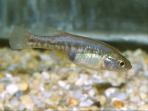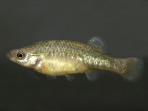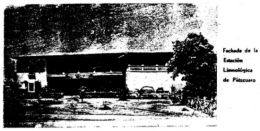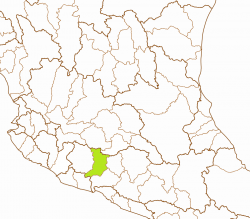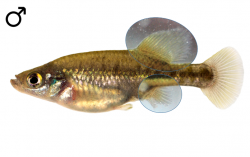- HOME
- WHO WE ARE
- NEWS AND DATES
- GOODEIDS
- PHYLOGENY
- ARTIFICIAL KEY
- GOODEID SPECIES
- BIOLOGY
- ENVIRONMENT
- CONSERVATION
- PROFUNDULIDS
- MEMBERS AREA
Allotoca meeki
English Name:
Zirahuén Allotoca
Mexican Name:
Tiro de Zirahuén
Original Description:
ÁLVAREZ DEL VILLAR, J. (1959): Contribución al conocimiento del genero Neoophorus (Pisc., Goodeidae). Ciencia, Méx. 19 (1-3): pp 13-22
Holotype:
Collection-number: Escuela Nacional de Ciencias Biológicas, Cat. No. ENCB P885.
The Holotype he deposited is an adult female of 52.1mm standard length, collected by Aurelio Solórzano Preciado on June the 29th, 1957. Another 13 individuals between 34.4 and 54.3mm long were taken with the Holotype, another 30 Paratypes from the same lake by Juan Pizá and José Guerra on August the 27th, 1958.
The left picture shows the front view of the limnological station in Pátzcuaro (Estación Limnológica de Pátzcuaro) in1940. Aurelió Solórzano Preciado, Biologist at the Oficina de Estudios Biologicos, Secretaria de Industria y Comercio, and formerly Director of the Estacion Limnologica, Pátzcuaro, was mainly interested in Atherinopsids from this lake and others and collected among others the types of Allotoca meeki from the Zirahuén lake. The right picture gives a historic view of the lake:
Terra typica:
The Holotype was collected in the Lago Zirahuén near Ajuno, federal state of Michoacán.
Etymology:
José Álvarez del Villar named the species after Seth Eugene Meek for his important work to increase knowledge about Mexican fish.
The genus Allotoca was erected by Hubbs and Turner, published by Turner in 1937 and taken from the manuscript of the famous monography about Goodeids that Hubbs & Turner finally published together in 1939. Though the authors mentioned the posterior insertion of the dorsal fin, "the more fundamental characters of Allotoca, however, are ovarian and trophotenial..." The word ἄλλος (állos) means different and τόκος (tókos) offspring, so the genus refers to the different looking trophotaenia of the fry with the generic name meaning "different offspring".
Synonyms:
Zoogoneticus diazi Meek (partially), 1902
Neoophorus diazi Hubbs & Turner (partially), 1939
Neoophorus diazi diazi de Buen (partially), 1942
Neoophorus meeki Álvarez del Villar, 1959
Distribution and ESU's:
The Zirahuén Allotoca is endemic to the Mexican federal state of Michoacán and is known only from the endorheic Laguna de Zirahuén basin, where it historically occured in the Laguna and in the Estanque de Condembas (Lago de Opopeo) in the town of Opopeo, about 14km E of the lagoon, with its waters flowing into the Río El Silencio, the main source of the Zirahuén lagoon. The species disappeared from the lagoon in the 1990's but persisted - despite of predacious Largemouth Bass (Micropterus salmoides) - in the spring fed lake in Opopeo and its effluent, the connection with the Río El Silencio. No subpopulations are distinguished. The bold names are the ones officially used by the Instituto Nacional de Estadística y Geografía; nevertheless, other ones might be more often in use or better known and therefore prefered.
ESU ist short for Evolutionarily Significant Unit. Each unit expresses an isolated population with different genetic characteristics within one species. ESU's can be defined by Molecular genetics, Morphology and/or Zoogeography and help in indicating different phylogenetic lineages within a species. The abbreviation for an ESU is composed of three letters of the genus, followed by the first two letters of the species name and an ongoing number in each species.
We do not distinguish any ESU within Allotoca meeki, so all fish belong to Altme1.
The left map shows the Río Tepalcatepec-Infiernillo basin from the Hydrographic Region Balsas on a Mexico map. Within the Río Tepalcatepec-Infiernillo basin, the Zirahuén Allotoca inhabits exclusively the Laguna Zirahuén subbasin (ZIR), shown on the right map:
Status :
International Union for Conservation of Nature (IUCN): Critically Endangered
Distribution and current conservation status of the Mexican Goodeidae (Lyons et al., 2019): Critically Endangered/declining: „This species is known only from the endorheic Lake Zirahuén basin, where it was once common. The introduction of non-native Micropterus salmoides (Centrarchidae), a fish predator, eliminated the species from Lake Zirahuén by the late 1990’s (DomínguezDomínguez et al., 2005). A population of A. meeki persisted in Lake Opopeo in the headwaters of a tributary system, but by the 2000’s M. salmoides had invaded this lake, and A. meeki had become scarce. A small population has persisted in a short segment of the outlet of the lake, which appears to be too narrow and shallow for M. salmoides.“
NOM-059-SEMARNAT-2010: no categoría de riesgo (no category of risk)
Habitat:
The Lago de Zirahuén is a small, but deep mountain lake with a sandy bottom that is partially covered with firm mud. The water is very clear. Probably this species lived within dense plant stands like Chara, Potamogeton, Ceratophyllum and green algae. The prefered depth is below 1m. A GWG survey to the Estanque de Condembas in Opopeo in 2014 revealed some Allotoca meeki in the effluent of the pond. This is a shallow and narrow creek, swift flowing and mostly covered with a Nasturtium related aquatic plant. On a survey to the same location in 2017, the group was able to rediscover the Zirahuén Allotoca in the pond itself together with Goodea atripinnis, again beneath dense vegetation. In the pond could be seen large schools of Largemouth Bass, some of them up to 30cm TL or even larger. Both Goodeid species were additionally found in the creek just about 100m from the pond.
Biology:
Miller reported about juvenile fish in February, a GWG collected a gravid female in March 2017. Due to the fact, that this species is very rare in the wild as well as in captivity, there's not much information available, but taking in consideration its close relationship with Allotoca diazi, a similar life history can be inferred.
Diet:
The dentition and the length of intestines of this species is similar to other Allotoca-species, which suggests, this species is carnivorous and feeds from small water-invertebrates and insects from the surface.
Size:
The maximum known standard length is 60mm (Miller et al., 2005).
Colouration:
The colouration of this fish has been described by Álvarez del Villar in the following way: "This species shows a lot of little irregular and more or less chestnut-grayish-coloured spots, forming bars on the lower part of the sides and from the origin of the insertion of the dorsal fin posteriorly. In some individuals, it looks like these spots overlay the dark bars so they don't appear so dark anymore. A lot of specimens show a small but very dark spot (darker than the other spots) isolated on the posterior part of the caudal peduncle, immediately at the base of the caudal fin. Within the majority of individuals, the dorsal half of the body is normally less spotted and looks brighter than the sides. The venter is very clear, whitish or cream-coloured and doesn't present spots."
Sexual Dimorphism:
At first appearance, males and females of the Zirahuén Allotoca are not very easy to distinguish. The safest characteristic is the Splitfin in males, means the for Goodeinae typical mating organ formed by a notch after the first seven shortened rays of the Anal fin. Additionally, male Allotoca meeki have a bigger Dorsal fin than females. A difference in colouration is almost not visible, except for a sometimes yellowish Anal fin in females. Females are a bit longer than males with a bigger and blunt head, but some experience is necessary to see these characters.
Remarks:
Allotoca meeki is barely distinguishable from diazi, closely related to it, and may even belong to this species. Following Álvarez del Villar, A. meeki appears more slender than diazi with bigger eyes than other species of the genus Allotoca. It has been extirpated from the Lago de Zirahuén as a result of predation by introduced Largemouth Bass and appears to persist only in the small Estanque de Condembas (Lago de Opopeo), a spring fed pond and resulting in an affluent of the Zirahuén lake. This pond is also populated with preadatory Bass meanwhile. Therefore, and due to its very sparse presence in Hobbyist tanks, Allotoca meeki has to be considered as one of the most endangered Goodeid species. As a result of it, the Austrian Association of Aquarists (ÖVVÖ) started a Studbook on this and all other Allotoca species (including the closely related Neoophorus regalis).
Husbandry:
Looking on the biotopes of Allotoca meeki, they suggest the species may prefer a habitat with moderate to swift current, structured with gravel, rocks, roots, branches, fallen leaves and river bank vegetation. Fry is eaten in some cases, but it may depend on the quantity and quality of food and on the number of places to hide. When several different stages of juveniles occur, fry may be neglected, so it makes sense to add separate brought up fry to the group with a size of 1.5 or 2cm to provide these stages and get a flock breeding colony.
The recommended tank size is at least 100 liters, bigger tanks with a generous base and little height (25cm are enough) are better for sure. With rocks and vegetation in the corners and backsinde of the tank well structured tanks combined with some roots and/or wood seem to do best with this species. The current should be moderate or swift, especially as the species is adapted to a high oxygene level (at least 8mg/l).
In the wild, the species feeds mainly from small or middle-sized invertebrates like bloodworms or insect larvae, so feeding with similar food, water fleas, Mysids and other food from animalistic sources will be best for this predatory fish. In aquarium, it feeds also well from flake food, granulate and even tablets, additionally given Nauplia of Brine Shrimps are eaten greedy. The species is not really shy, but likes to use hiding spots to observe the surrounding.
Concerning water quality, this species is in need of bigger water changes (60-80% every week) like most of the Goodeids, especially river and spring inhabiting species, so an automatic water changing system can be helpful. Otherwise, in combination with constant temperatures higher than 24°C, fish may get sick, lose resistance against diseases and age too fast. So for keeping the strain healthy and strong, give the fish a rest during winter time with temperatures lower than 20°C for 2 or 3 months so they stop producing fry. Allotoca species can be kept down to temperatures of 15 or 16°C without problems for months, some species even lower. In spring, when the temperature slowly increases, they will start spawning at 20 or 21°C and won't stop until it gets colder again or when it gets too warm (25°C).
This species is doing very well when is kept in the open from spring to fall, starting when the water temperature by day exceeds 15°C and cold periods are no longer expected. Bring them out in the early afternoon, the time of the day with the highest water temperature. During the warm summer, reproduction will stop and may occur again in fall. Bring the fish in before the water temperature deceeds 15°C by day and keep them cool for the first days, then slowly raise the temperature but try to stay below 20°C over the winter time.
Populations in holding:
Here each species are assigned populations of fish in husbandry and in brackets aliases of these locations to assist in identifying own stocks. Each population is assigned a unique Population-ID, composed by the ESU, the subbasin where this population is occurring (three capital letters) and a unique location identifier.
Populations in holding:
1. Altme1-ZIR-Opo
Population: Opopeo (aka Lago de Opopeo, Laguna de Opopeo)
Hydrographic region: Balsas
Basin: Río Tepalcatepec-Infiernillo
Subbasin: Lago de Zirahuén
Locality: Estanque de Condembas and its effluent in Opopeo








